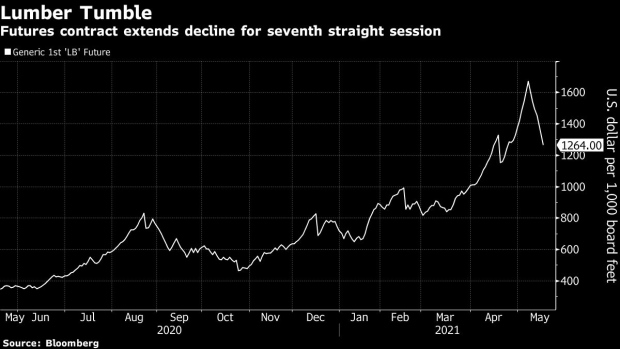May 18, 2021
Lumber futures’ rout deepens to 27 per cent, hinting at rally’s end
, Bloomberg News
Christine Poole discusses lumber
While builders are still paying record-high cash prices for lumber, the futures market is signaling that the historic rally could be coming to a close.
The lumber contract for July delivery fell US$63 on Tuesday, the maximum permitted by the Chicago Mercantile Exchange, with the price sinking to US$1,264 per 1,000 board feet. That’s the seventh straight session of falling prices for the futures contract, marking the longest streak of declines since September. Lumber’s most-active futures contract is down 27 per cent from its May 10 peak of US$1,733.50, a level more than four times higher than prices a year ago.

While the drop suggests market weakness, with traders saying the preceding rally went too high, builders who need to buy wood for summer projects are still paying top dollar due to strong demand and tight supplies at sawmills. Higher costs and limited availability of building materials have halted some projects, according to the National Association of Home Builders.
Demand for wood remains robust among retailers including Home Depot Inc., which is reporting strong sales in lumber products as well as across its home-improvement business.
“We compare it to a storm environment where literally as soon as you bring it in, it’s selling,” Home Depot Chief Financial Officer Richard McPhail said Tuesday in an interview. “We’re really just focused on making sure we stay in stock and making sure we have the appropriate level of staff to serve our customers. The market will go where it goes.”
The Fastmarkets Random Lengths U.S. Framing Lumber Composite Index soared to a record US$1,495 per 1,000 board feet on Friday, the most recent pricing. That is up 6 per cent from the week prior and nearly four times the price of a year ago. A composite index for oriented strand board, a plywood substitute product, jumped 3 per cent from the previous week to US$1,426 per 1,000 square feet, five times more than a year ago.
Lowering prices
“The mills have this order file where they’ve sold the physical production through the middle of June,” said Westline Capital Strategies Inc. Chief Executive Officer Greg Kuta, whose Ohio-based firm specializes in lumber trading strategies. “They don’t have to come to the open market here and take counteroffers on their physical cash for at least two to three weeks.”
While futures are leading the way down, Kuta doesn’t expect the cash price of immediately available lumber to likely follow until mid-June at the earliest since demand from builders remains strong. The futures and cash markets will likely converge two to four weeks before the July contract expires on the 15th of that month, he said.
Mills could start lowering prices by the end of this week though such a drop won’t be as steep as with futures contracts, according to Brian Leonard, an analyst for RCM Alternatives in Chicago.
“Futures are getting driven down right now by computerized trading and other platforms not related to the physical product, so it may end up going lower than the real market needs to go,” he said. “The mills know there’s a lot more buying than needs to happen.”
He expects the cash market will fall to a new base level in June and trigger more buying, while futures could head back up by August. Leonard said he has seen this pattern repeat in his 35 years of trading in the market.
“The market is digesting some very high levels right now,” he said. “I don’t know if we’ll make a new high, but I think we’ll take a shot at it again.”





